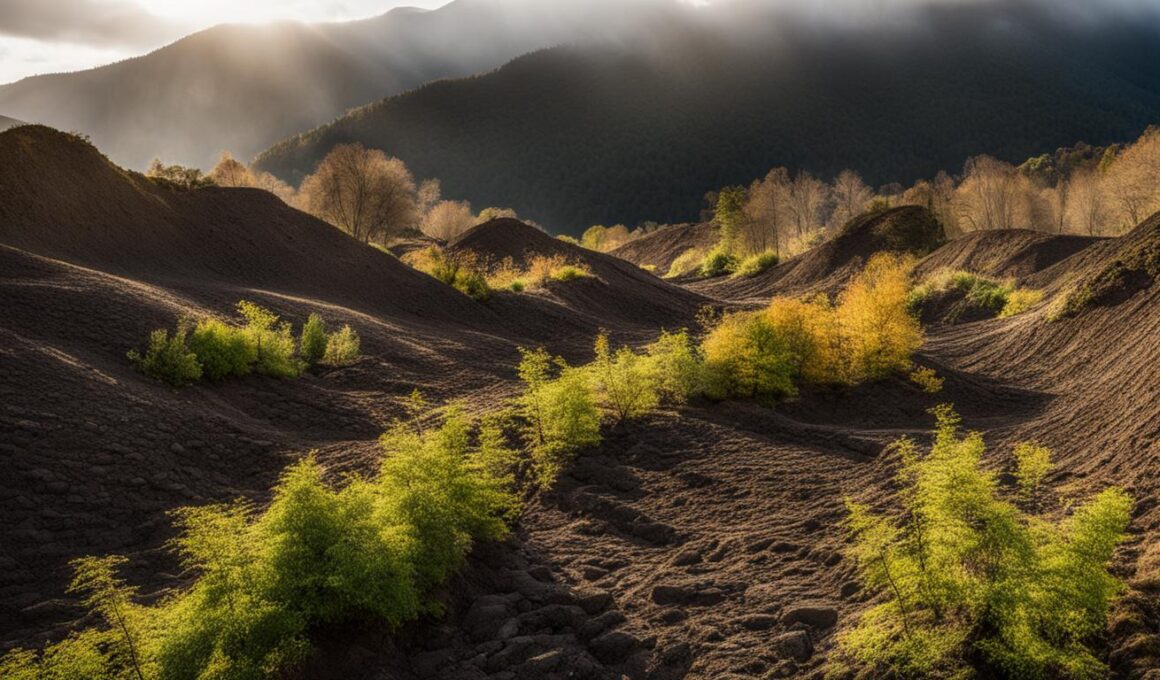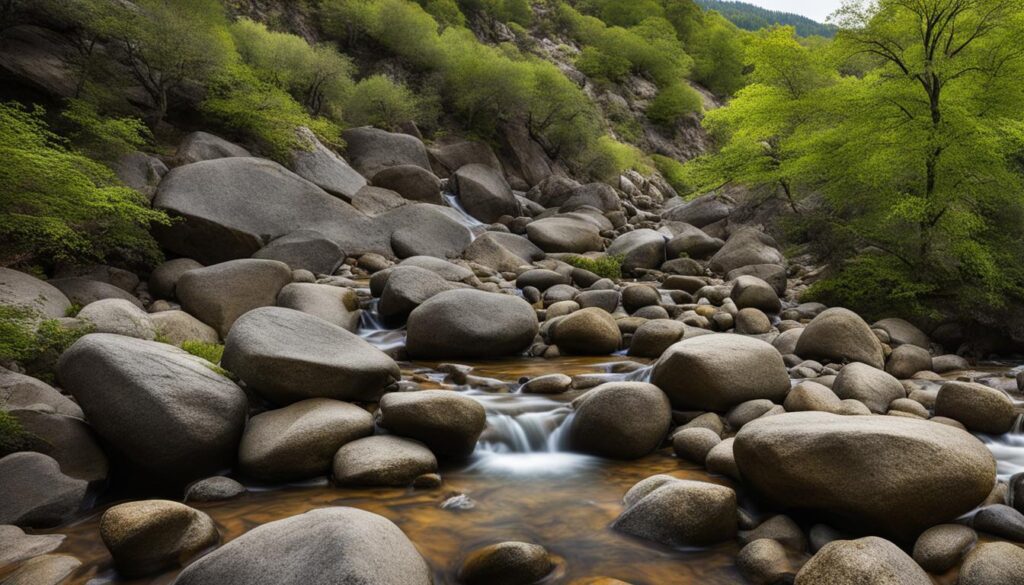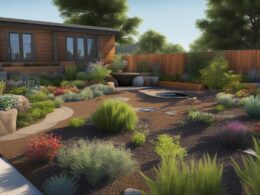Discover how to enhance your landscape, conserve water, and protect your soil with xeriscape mulching and erosion control techniques. By implementing these eco-friendly methods, you can prevent damage caused by erosion due to heavy rain and winds. Learn the key techniques for slope stabilization and the prevention of erosion, and create a sustainable landscape that promotes water conservation and landscape conservation.
Erosion can have detrimental effects on your landscape and the environment. It occurs when the top layer of soil is loosened and worn away, leading to damage and runoff pollution. To determine if your slope is at risk for erosion, consider factors such as steepness, non-hardy vegetation, compacted or depleted soil, and soil disturbance. By implementing xeriscape mulching and erosion control techniques, you can mitigate these risks and protect the health of your landscape.
Key Takeaways:
- Xeriscape mulching and erosion control techniques enhance your landscape and protect your soil.
- Erosion can cause damage to your landscape, including runoff pollution.
- Assess the risk of erosion by considering factors like slope steepness and non-hardy vegetation.
- Implementing xeriscape mulching and erosion control techniques can mitigate erosion risks.
- Create a sustainable landscape that promotes water and soil conservation.
Temporary Solutions for Erosion Control: Straw Wattles and Mulch
Erosion can cause significant damage to your landscape, leading to soil loss, runoff pollution, and potential destruction of vegetation. Implementing temporary solutions for erosion control is crucial to prevent further damage and stabilize slopes. Two effective temporary solutions for erosion control are straw wattles and mulch.
Straw wattles are horizontal barriers made of compressed straw tubing wrapped in biodegradable materials like jute. They are installed in small trenches across a hillside and can effectively control erosion for one to two years. Straw wattles act as sediment filters, allowing water to flow through while trapping sediment and preventing it from eroding further down the slope. They are cost-effective and environmentally friendly, providing immediate protection to vulnerable areas.
Mulch is another temporary solution that can help stabilize slopes and control erosion. Organic mulch materials, such as shredded bark, should be applied at least two to three inches deep to provide sufficient protection against rain and wind impacts. Mulch helps reduce the impact of raindrops, minimizes soil compaction, and slows down water flow, allowing it to infiltrate the soil gradually. This not only reduces erosion but also helps retain moisture and promote healthy root growth.
By utilizing these temporary erosion control solutions, you can effectively stabilize slopes, reduce erosion, and protect your landscape while you plan for long-term permanent solutions.
| Temporary Solutions | Benefits |
|---|---|
| Straw Wattles | Immediate erosion control |
| Mulch | Reduce soil compaction and water runoff |
Permanent Methods for Erosion Control: Vegetation, Soil Amending, Grading, Retaining Walls, Terracing, and Drainage
When it comes to long-term erosion control, permanent methods are key to stabilizing slopes and protecting your landscape. These methods include the use of hardy vegetation, soil amending, grading, retaining walls, terracing, and drainage. By implementing these techniques, you can create a sustainable environment that is resistant to erosion and promotes the growth of healthy vegetation. Let’s explore each of these methods in detail:
Hardy Vegetation:
Choosing the right plants for slopes and the local environment is crucial for erosion control. Hardy vegetation with deep root systems can withstand heavy rain and help anchor the soil. Some examples of hardy plants suitable for erosion control include grasses like fescue and buffalo grass, as well as groundcovers like creeping juniper and periwinkle.
Soil Amending:
Amending the soil is an essential step in creating a stable foundation for your landscape. Adding organic matter such as compost or well-rotted manure can improve soil structure and water retention. This allows the soil to better absorb and retain moisture, reducing the risk of erosion.
Grading, Retaining Walls, and Terracing:
Grading involves reshaping the slope to redirect water flow and reduce slope steepness. Retaining walls are structures built to hold back soil and prevent erosion. Terracing creates level areas on slopes, providing space for vegetation to grow and reducing erosion. These techniques work together to create a more stable landscape and minimize the risk of erosion.
Drainage:
Proper drainage is crucial in preventing water from pooling and causing erosion. Installing drainage systems, such as French drains or swales, can help redirect water away from slopes and prevent erosion. By effectively managing water flow, you can protect your landscape from the damaging effects of erosion.
| Method | Description |
|---|---|
| Hardy Vegetation | Choose plants with deep root systems that can withstand heavy rain and anchor the soil. |
| Soil Amending | Add organic matter to improve soil structure and water retention. |
| Grading | Reshape the slope to redirect water flow and reduce slope steepness. |
| Retaining Walls | Build structures to hold back soil and prevent erosion. |
| Terracing | Create level areas on slopes to support vegetation growth and reduce erosion. |
| Drainage | Install systems to effectively manage water flow and prevent pooling. |
By implementing these permanent erosion control methods, you can create a landscape that is not only visually appealing but also sustainable and resistant to erosion. These techniques work together to protect your soil, conserve water, and promote the growth of healthy vegetation.
Rock Placement as an Erosion Control Method
Erosion control is a crucial aspect of landscape conservation, and rock placement offers an effective solution that combines functionality with aesthetic appeal. By strategically placing rocks on slopes, you can prevent soil erosion and maintain the stability of your landscape. Different types of rocks can be used depending on your specific needs, such as cobblestones, gravel, non-absorbent stone, and riprap. These options provide both functional and visual benefits while effectively controlling erosion.
Cobblestones are an ideal choice for allowing water, nutrients, and root systems to move through the soil, promoting a healthy environment for vegetation. Gravel, on the other hand, provides a layer that holds soil in place, preventing erosion caused by heavy rain and winds. Non-absorbent stone, such as clay or certain types of granite, can be used for supporting terraces or retaining walls, adding structural stability to your landscape. For severe erosion situations, riprap stones, large rocks that lock into place, are an excellent option.
When implementing rock placement as an erosion control method, consider incorporating techniques such as retaining walls, anchoring plant beds with boulders, creating rock toes for shorelines, and building rock terraces. These techniques not only enhance slope stability but also add an aesthetic touch to your landscape. The strategic placement of rocks can create visually appealing focal points and complement the overall design of your outdoor space.
Benefits of Rock Placement for Erosion Control:
- Prevents soil erosion on slopes
- Maintains the stability of your landscape
- Allows for water, nutrients, and root systems to move through the soil
- Provides protection against heavy rain and winds
- Adds aesthetic appeal to your outdoor space
Implementing rock placement as an erosion control method not only protects your landscape from erosion but also enhances the overall beauty and functionality of your outdoor space. By choosing the right rocks and incorporating them strategically, you can create a landscape that is both visually stunning and environmentally sustainable.
Table: Comparison of Rock Types for Erosion Control
| Rock Type | Main Characteristics | Best Application |
|---|---|---|
| Cobblestones | Allow water, nutrients, and root systems to move through the soil | Slopes with vegetation |
| Gravel | Provides a layer that holds soil in place | Slopes prone to erosion |
| Non-absorbent stone | Supports terraces or retaining walls | Structural stability |
| Riprap stones | Large rocks that lock into place | Severe erosion situations |
Can Layering Mulch Help with Erosion Control in Xeriscaping?
Layering mulch in xeriscaping can be an effective method for erosion control. By creating layers of mulch, you can help to prevent soil erosion and retain moisture in the soil, which is crucial in xeriscaping. This technique also helps to enhance the overall aesthetic of the xeriscape design.
Conclusion
Xeriscape mulching and erosion control techniques are crucial for creating a sustainable landscape that promotes water conservation and protects your soil. By implementing a combination of temporary solutions, such as straw wattles and mulch, and permanent methods including vegetation, soil amending, grading, retaining walls, terracing, and drainage, you can effectively stabilize slopes, prevent erosion, and create an eco-friendly environment.
Rock placement is another innovative method for erosion control that not only adds functionality but also enhances the aesthetic appeal of your landscape. With the right choice of rocks, such as cobblestones, gravel, non-absorbent stone, and riprap, you can effectively control erosion while maintaining the beauty of your outdoor space.
Remember, xeriscape mulching and erosion control techniques are not limited to dry areas or cactus gardens. They can be applied to any type of garden design, promoting the conservation of water and the protection of our environment. By selecting appropriate plants, improving soil quality, using organic mulch, and practicing efficient watering, you can create a water-wise garden that not only saves water but also enhances the health and beauty of your landscape. Start implementing these techniques today and enjoy the benefits of a sustainable and resilient outdoor space.










